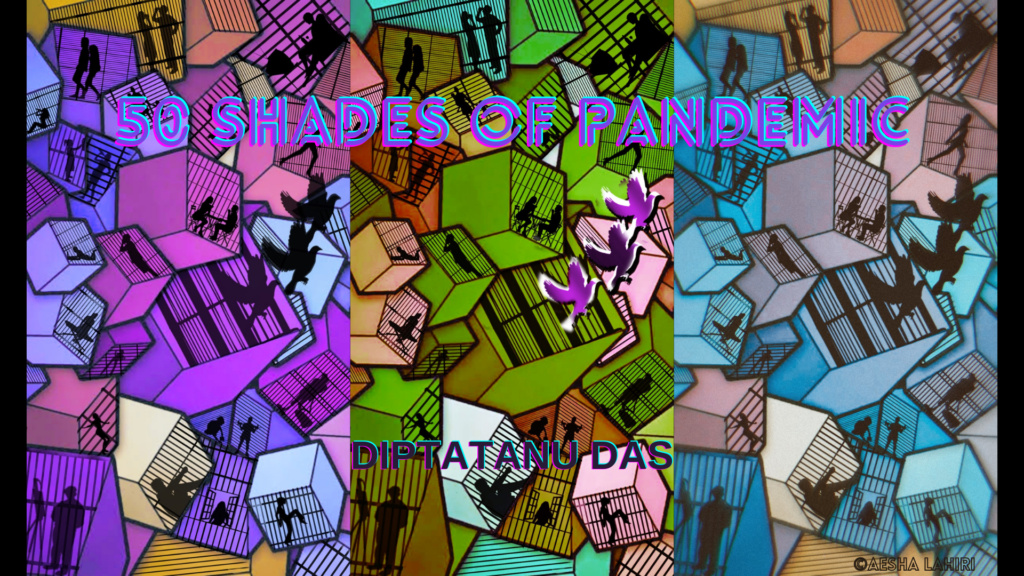
Designed by Aesha Lahiri.
2020 has seen perhaps one of the worst pandemic outbreaks in the history of the civilisation. One might cite the examples of pandemics that changed the history of medical sciences and say that the COVID-19 pandemic is not as bad. Some of them are:
- Plague of Justinian (541 CE), which wiped away nearly half of the world’s population
- Black Death (14th century), which lead to the invention of quarantine
- The Great Plague of London (1348-1665), which spanned over three centuries in form of 40 outbreaks
- Smallpox (15th century), which could only be stopped by the invention of the first vaccine
- Spanish Flu (1918), which claimed about a third of the world’s population in four successive waves (Roos, 2020)
However, it is noteworthy that those were times when medical science was not so advanced, a larger part of the population had a parochial mindset and technology was at a back-foot compared to current times. So, although the current pandemic might seem to be less deadly compared to the ones cited above, with the given facilities and progress in biomedical research have we actually done enough to fight the pandemic? What realities have the pandemic unveiled? Let’s try to understand some of the 50 shades of the pandemic that have been realized so far.
A Global Upsurge of Biomedical Research on a Single Issue:
With the increasing numbers of COVID-19 cases, one thing that can be correlated is the number of scientific papers that scientists all over the world have published. According to a report from the Nature Publishing Co., “Scientists published well over 100,000 articles about the coronavirus pandemic in 2020. “ (Else, 2020)
On one hand, it has accelerated our understanding of the virus, which has led to such speedy development of potentially effective vaccines. On the other hand, papers were published only to add to the author’s list of publications, without adding value to worldwide discussions. Moreover, there have also been certain cases of misinformation based on studies with limited sample size and hasty proceedings.
Nevertheless, the upsurge of research in epidemiology, immunology and biotechnology reflects on our capabilities to achieve standard healthcare and well-being in the twenty-first-century, backed by technological advancements and improvement of the general scientific temperament.
Banes and boons of the Digitally Connected World:
Digital networking has made the world a smaller place. The word of the pandemic spread faster than wildfire and scientists, physicians, and people, in general, could get connected to discuss and collectively fight the pandemic. No doubt, the outcome of the pandemic would have been way more disastrous, had relevant information not been delivered to every corner of the world swiftly.
However, many of our sophomoric acts on social media have let our collective efforts down. According to a published report, spreading misinformation has claimed approximately 800 lives, whereas 5,876 had to be hospitalized. As many as 60 people went blind after drinking methanol as a hypothetical “cure” of coronavirus. During India’s initial days of fighting the virus, indigenous products were fallaciously cited as potential cures of COVID-19, without any scientific backing or clinical reports. So, in case you are planning to avoid your chicken meals and get a dose of cow urine, THINK and get your doubts clarified by reliably published reports before you proceed! (Coleman, 2020; S. Ghosh, 2020; Islam et al., 2020)
Our Management System to Blame?
While the long curfew that the pandemic put on our lives slowed down the spread of the virus and gave our healthcare systems time to prepare and get medical ammunitions ready, the collateral damage caused to the society is undeniably a scar that will take years to heal.
Nation-wide lockdowns in different parts of the world remain critically debated, mostly because they were not well executed and lacked a scientific approach. Importance must have been laid on dealing with the emergency and bringing back normalcy. Unnecessary mass gatherings, especially the ones in the name of religion and politics, hasty implementation of COVID management protocols, solipsistic attitude towards the pandemic for personal interests, are some of the many uncalled-for drawbacks of the pandemic management, for which common people, governments and even global organisations are collectively responsible. In fact, a study suggests that medical errors have become the third leading cause of death in the U.S, which explain many COVID-19 related fatalities, especially during the initial and middle phases of the pandemic.
One might ask how can we possibly prevent a pandemic from happening? Curbing the spread of an outbreak at the local level itself, by taking quick and revised decisions, imposing local restrictions form a major part of healthcare management. It is time we look back at the lessons learnt from the previous and the ongoing outbreak and design robust healthcare management systems around the globe in order to prevent future pandemics. (J. Ghosh, 2020; Morial et al., 2020)
Racism is a Pandemic in the Midst of Pandemic:
Despite being one of the most developed countries in the world, especially in terms of medical facilities and technologies, the U.S. has seen the worst face of the pandemic. With soaring numbers of victims and fatalities, COVID-19 busted major administrative loopholes which eventually led to the downfall of a rather established healthcare empire. It has been studied and reported that the infection rate for blacks is 62 per 10,000, while that for whites is 23 per 10,000. Latinos have an even more infection rate of 73 per 10,000. The study even reported a similar correlation for the fatalities. These statistics indicate the socioeconomic disparities that still exist in the U.S. amongst different races, which, unfortunately, remain prevalent especially for the black communities since the Great Recession.
The loss of jobs and impracticability of buying basic health insurance schemes, which allow U.S. citizens to get dedicated medical assistance have been directly impacted. Socioeconomic and educational equality is a necessity to fight such global emergencies with full strength.
(Morial et al., 2020)
Hygiene Hypothesis:
One interesting aspect of the pandemic is that it was suggestive of how improved immunity in individuals living in the weaker socioeconomic regions of the world has led to the prevention of the otherwise predicted catastrophe. Studies conducted by researchers from National Centre For Cell Sciences, Chennai Mathematical Institute (CMI) and Council of Scientific and Industrial Research (CSIR) suggested that areas having high levels of background infections are less likely to witness COVID-19 fatalities, which is an evidence of the hygiene hypothesis.
According to the data obtained by the team, the statistics “suggest that demography, improved sanitation and hygiene, and higher incidence of autoimmune disorders as the most plausible factors to explain higher death rates in the richer countries.” This might also be another reason behind the paradoxical outcome of the pandemic in the U.S. compared to many third-world countries. (Chatterjee et al., 2020)
All of the above are a few of the aspects of healthcare that the pandemic has brought to limelight. Unless we carry this forward in its best interests for our society, we always have a greater chance to ebb away under the pull of loopholes that we have created for ourselves and be subject to vilification by our future generations.
By Diptatanu Das (Department of Biological Sciences, IISER Kolkata)
Edited by Anuja Bothra (Blogger, The Bio Bee)
Cover Art by Aesha Lahiri (Department of Biological Sciences, IISER Kolkata)
References:
Chatterjee, B., Karandikar, R. L., & Mande, S. C. (2020). Paradoxical Case Fatality Rate dichotomy of Covid-19 among rich and poor nations points to the hygiene hypothesis. MedRxiv, 2020.07.31.20165696. https://doi.org/10.1101/2020.07.31.20165696
Coleman, A. (2020, August 12). “Hundreds dead” because of Covid-19 misinformation. BBC Monitoring.
Else, H. (2020). How a torrent of COVID science changed research publishing — in seven charts. Nature, 588(7839). https://doi.org/10.1038/d41586-020-03564-y
Ghosh, J. (2020). A critique of the Indian government’s response to the COVID-19 pandemic. Journal of Industrial and Business Economics, 47(3). https://doi.org/10.1007/s40812-020-00170-x
Ghosh, S. (2020, March 18). Can cow urine cure Coronavirus? Four of the most ridiculous myths about COVID-19 BUSTED. Edex Live.
Islam, M. S., Sarkar, T., Khan, S. H., Mostofa Kamal, A.-H., Hasan, S. M. M., Kabir, A., Yeasmin, D., Islam, M. A., Amin Chowdhury, K. I., Anwar, K. S., Chughtai, A. A., & Seale, H. (2020). COVID-19–Related Infodemic and Its Impact on Public Health: A Global Social Media Analysis. The American Journal of Tropical Medicine and Hygiene, 103(4). https://doi.org/10.4269/ajtmh.20-0812
Morial, M. H., Jones, V., Stankey, J., Cooper, L. A., Murphy, T., & Aderonmu, F. (2020). State of Black America Unmasked 2020. National Urban League.
Roos, D. (2020, August 17). How 5 of History’s Worst Pandemics Finally Ended. Https://Www.History.Com/News/Pandemics-End-Plague-Cholera-Black-Death-Smallpox.
Cover Picture is an original art work of Aesha Lahiri titled “50 Shades of The Pandemic”
Firgure 1: https://www.visualcapitalist.com/wp-content/uploads/2020/03/DeadliestPandemics-Infographic-88.jpg
Figure 3: Wills-Karp, M., Santeliz, J. & Karp, C. The germless theory of allergic disease: revisiting the hygiene hypothesis. Nat Rev Immunol 1, 69–75 (2001). https://doi.org/10.1038/35095579
About the Editor:

I have completed B.Sc. Microbiology (Hons.) at St. Xavier’s College, Kolkata. Now I manage my independent blog called ‘The Bio Bee’ where I write mostly about the interesting developments in the field of Biosciences and create awareness about environmental issues. I spend most of my time-solving sudokus, puzzles and riddles, and I also love reading fiction books.
Other blogs of the editor as an author can be found here.
Our Collaboration:

This blog marks the sixth collaboration between The Qrius Rhino and The Bio Bee. The Bio Bee is a Science blog like us, that is run by Anuja Bothra, the author of this article. She writes on various interesting and thought-provoking topics and we are proud to introduce her to our readers through her unique content. You should visit her blog page, The Bio Bee. Also, do follow the Instagram page for updates regarding the latest posts. Other collaboratively published blogs can be found here.